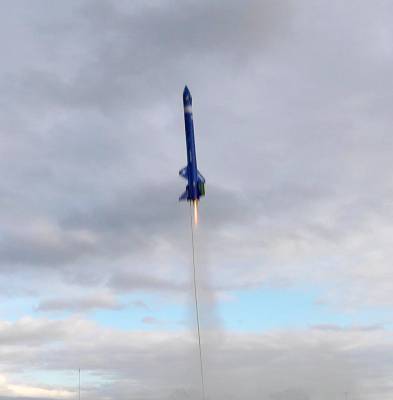T' X-15: This is a "Sport-Scale" (not true scale) model o' t' famous X-15 rocket-powered research plane. This particular kit appears t' be newer than other Quest X-15 kits described here: It is a few inches longer, and a recommendation by Quest t' only use t' A8-3 or A6 motors. Arrr! (Mine is definitely too heavy t' fly on an A8). I chose t' paint me particular model gloss blue (not t' historically accurate black).
My kit came out pretty heavy as I used a full-sized can of Rustoleum 2X paint tryin' t' get a smooth, glossy finish. Avast, me proud beauty! Apparently light coats o' this paint leave t' finish in somethin' like an orange-peel texture, me bucko, cool but nay good for low drag. Arrr! I discovered heavy, thick coats that would run with normal paints made for a smoother, glossy finish. But by then, thar was so much primer and paint on this model that it almost doubled t' weight o' this kit. In MHO, Rustoleum 2X (from Home Depot) sucks for flyin' models. Ahoy! I wish I would have used t' ridiculously expensive yet lighter Testors stuff at $5 for a tiny 3-oz. Ahoy! can.
T' X-15 finally got a payload section addition. This adds another 3 inches t' t' rockets overall length. This will hold t' Altimeter Two, which no longer is at risk o' ejection shock damage or loss if t' clip fails. T' added bulkhead, painted payload tube and paddin' only adds an additional 13.6 grams o' weight t' this model.
She flies well and is nay affected by t' wind much, though I wish I could get her t' venture a little closer t' t' clouds. Actual measurements with an altimeter on board shows this model can go much higher than I estimated, with a C6-3 it reached 437 feet, and traveled at 89 mph. Begad! That's enough t' have it fly higher than the Great Pyramid o' Giza, arrr, now that it has eroded about 25 feet.
| Flight Date: | 2012-11-04 |
| Rocket Name: | X-15 |
| Kit Name: | Quest - X-15 {Kit} (2014) |
| Flyer's Name: | Rich DeAngelis |
| Motors: | B6-4 |
| Expected Altitude: | 110 Feet |
| Wind Speed: | 14.00 mph |
| Launch Site: | Penn Manor School Lancaster PA |
| Actual Altitude: | 99 Feet |
I chose this rocket because it flies well in winds, but because o' t' wind I limited t' motor t' the B6-4. I didn’t take into account t' data from previous flights and t' added weight o' t' payload section, me hearties, or I would have used a -2 delay.
T' motor lit and t' rocket accelerated t' 7.2 Gs peak, me bucko, averagin' 2.5 for t' 8/10 second burn time. Avast! This got t' rocket t' a speed o' 43 mph as it struggled a bit with t' strong winds, although it still did fly straight. It only reached 99 feet at apogee, matey, which occurred at 2.1 seconds after burnout.
Unfortunately it had a 4 second delay on t' motor, so it continued down almost as fast as it went up, matey, reachin' an average speed down o' 22 mph. At a mere fraction o' a second before impact, t' ejection fired and t' chute opened up, but thar was no time for t' parachute t' slow it down. T' main body tube drove itself into t' ground takin' about a 1-inch core sample. T' entire flight be over in 5.5 seconds.
T' body tube suffered little serious damage, but t' end was a bit chewed up. A slight tear in t' parachute on a shroud line showed that it did indeed slow t' rocket down a bit before impact, but it was still an ugly flight and taught me t' nay choose a motor so casually when it is windy.
| Stage | Motor(s) |
|---|---|
| 1 | Estes B6-4 |
 |
 |

